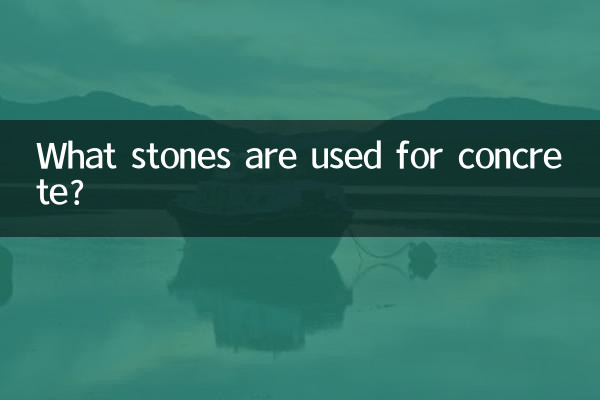What kind of stones are used for concrete: analysis and structured data of hot topics across the Internet
As a basic material in the construction industry, the quality of concrete is directly related to the safety and durability of the project. The selection of stones is a key link in the proportion of concrete. Recently, there has been a heated discussion on the entire Internet around "What stones to use for concrete?" This article will combine the hot content of the past 10 days to provide you with structured data and analysis.
1. Main types and characteristics of stones used in concrete

| Stone type | Particle size range (mm) | Advantages | Disadvantages | Applicable scenarios |
|---|---|---|---|---|
| pebbles | 5-40 | Smooth surface and good fluidity | Weak bond with cement | Ordinary civil buildings |
| gravel | 5-31.5 | Sharp edges and high strength | Poor liquidity | bridges, high-rise buildings |
| Machine-made sand | 0.15-4.75 | Controllable gradation and low cost | Powder content needs to be controlled | Prefabricated components |
2. Recent hot topics of discussion
According to the data analysis of the entire network, the discussion about concrete stones in the past 10 days mainly focused on the following aspects:
| Hot topics | Discuss the popularity index | core ideas |
|---|---|---|
| Effect of stone particle size on strength | 85 | The optimal particle size is 5-20mm, and continuous gradation is better than single particle size. |
| Environmentally friendly recycled aggregate applications | 78 | The construction waste recycling rate reaches 30%, which can meet the needs of concrete below C30 |
| Stone mud content control standards | 72 | The new national standard requires mud content ≤1.0%, which is 0.5% higher than the old standard. |
3. Technical specifications for stone selection
According to the standard requirements of GB/T14685-2022 "Pebbles and Gravel for Construction":
| Technical indicators | Class I standard | Class II standard | Class III standard |
|---|---|---|---|
| Crushing indicator (%) | ≤10 | ≤20 | ≤30 |
| Needle flake content (%) | ≤5 | ≤15 | ≤25 |
| Water absorption (%) | ≤1.0 | ≤2.0 | ≤3.0 |
4. Recommendations for the proportion of stones in concrete with different strength levels
| concrete grade | Stone type | Maximum particle size (mm) | Dosage (kg/m³) | Sand rate (%) |
|---|---|---|---|---|
| C15-C20 | pebbles | 40 | 1200-1350 | 38-42 |
| C25-C30 | gravel | 31.5 | 1100-1250 | 35-40 |
| C35-C40 | gravel | 25 | 1000-1150 | 32-38 |
5. Expert advice and industry trends
1. The application proportion of manufactured sand continues to rise, with the market penetration rate reaching 45% in 2023, an increase of 8% from last year;
2. In the green building evaluation standards, the use of recycled aggregates can gain up to 15 bonus points;
3. The intelligent aggregate grading system can increase the utilization rate of gravel by 20% and reduce waste;
4. High-performance concrete tends to use small-sized stones of 5-10mm to improve density.
It can be seen from the above structured data that the selection of concrete stones requires comprehensive consideration of strength requirements, construction conditions and cost factors. As technology advances and environmental protection requirements increase, the application of recycled aggregates and machine-made sand will become a future development trend. It is recommended that engineering units make scientific material selections based on specific project needs and refer to the latest national standards.

check the details

check the details